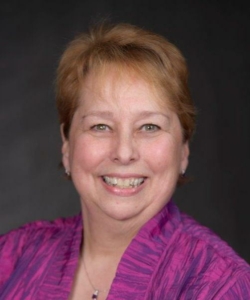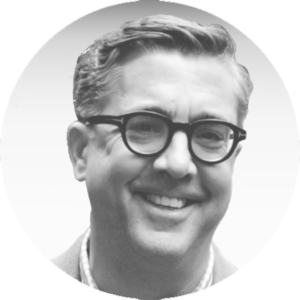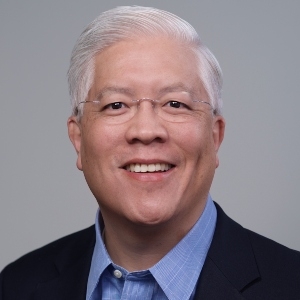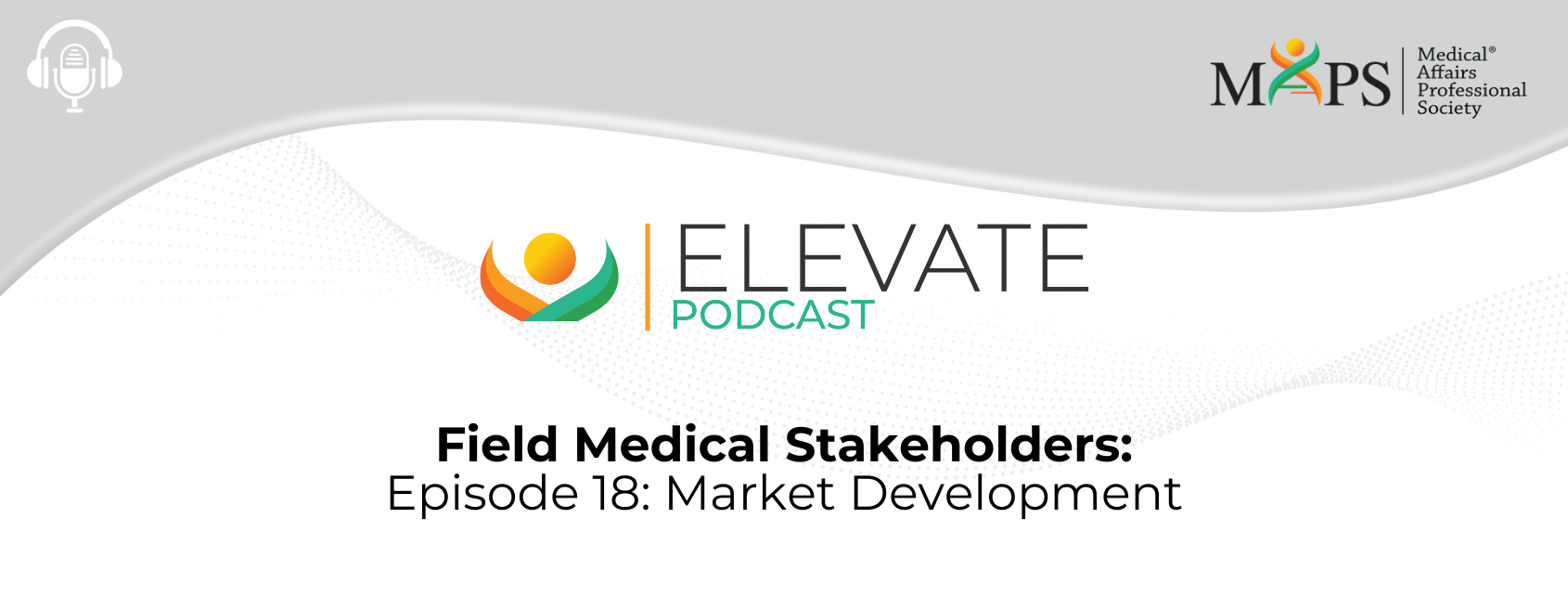Field Medical Stakeholders: Episode 18 — Market Development
Objectives:
At the end of this series of podcasts, the participant should be able to:
- Discuss the functions and activities of key internal partners
- Identify potential areas for compliant collaboration by MSLs with key internal partners

MODERATOR: Kathryn Gann, PhD

INTERVIEWER: Robert Groebel

INTERVIEWEE: John Yee, MD, MPH
Following is an automated transcription provided by otter.ai. Please excuse inaccuracies.
Kathryn Gann
Welcome to the Medical Affairs Professional Society Field Medical Focus Area Working Group’s podcast series entitled, “Field Medical Stakeholders: Partnering for today and tomorrow.” In this 18th podcast, we will be exploring the responsibilities of a Chief Medical Officer. I’m Kathryn Gann. I’m a member of the Field Medical Focus Area Working Group, and I’ll be the moderator for this podcast. Currently, I’m an independent consultant in Medical Affairs, having spent my 30 year career as an MSL, an MSL manager, and an MSL trainer.
Our legal disclaimer is as follows: The views expressed in this recording are those of the individuals and do not necessarily reflect on the opinions of MAPS, or the companies with which they are affiliated. This presentation is for informational purposes only, and is not intended as legal or regulatory advice.
We encourage you to engage in conversations about Field Medical with other MAPS members via MAPS Connect on the MAPS website or mobile app. Simply log in with the email address and password associated with your MAPS account and access the Global Community. Then click on the discuss tab and scroll down to Field Medical subject area to post a question or review previous postings.
The objectives for this series of podcasts are: that at the end of this series, the participant will be able to one, discuss the functions and activities of key internal stakeholders and to identify potential areas for compliant collaboration by MSL with key internal stakeholders.
I’d like to thank today’s panelists for sharing their subject matter expertise with MAPS membership. Speaking today are Robert Groebel, Vice President, Global Medical Strategy at Monocl. Robert will be our interviewer. And John Yee, Chief Medical Officer at Sobi North America. John is our interviewee. Robert, could you please briefly provide some information about your current position? How long you’ve been doing it what you do now? And then I’ll turn it over to you.
Robert Groebel
Thanks very much, Kathy. I’m currently the Vice President of Global Medical Strategy at Monocl. We’re a cloud-based software company that focuses on insights designed to improve the impact and value of Medical Affairs globally. John, why don’t you introduce yourself?
John Yee
Yes. Hi. Thank you, Robert. And thank you for having today having me today. My name is John Yee. I am Chief Medical Officer for North America at Sobi Pharmaceutical Company. Sobi is a Rare Disease pharmaceutical company. I have been at Sobi for just over a year, although I’ve been in the pharmaceutical industry now for more than 20 years. I’m really happy to be here together with all of you.
Robert Groebel
That’s great. So why don’t we jump right in? John, can you explain the role that you have currently as Chief Medical Officer at Sobi?
John Yee
Thanks, Robert. The Chief Medical Officer role is a little bit different at each company. But let me describe the role that I have at Sobi. We define the medical team quite broadly: it includes, obviously, our MSL team, our brand medical teams. We also have patient advocacy, HEOR, and real world evidence, as well as regulatory affairs. That’s really the broad scope of Medical Affairs at Sobi. I guess the way that I think about my role, as the leader of this team, is that I lead the team in four different directions. One is, of course, I lead our team itself. Second, I also serve on our North American leadership team and help lead the entire region for Sobi. But there, I also work with our colleagues at Sobi around the world, in particular, our global colleagues who are based in Europe. And probably the fourth dimension, and in many ways the most important dimension, is I lead our team as we engage with our external scientific stakeholders and key opinion leaders.
Robert Groebel
Excellent and as you said, John, I was going to kind of tease out the fact that you’ve had a career that has had leadership roles in Big Pharma and leadership roles in a number of biotech and emerging size companies. Do you see a difference in in how the Chief Medical Officer role is in one versus the other?
John Yee
Well, it is different, and you’re right, I’ve worked at companies of all different shapes and sizes from very, very small prior to launch to very, very large, multinational pharmaceutical companies. I think the role has its differences in terms of the scope of the medical team at each company. But I think the central purpose is always the same, you know? It is our job to identify what are the key unmet medical needs, as well as the key unanswered scientific questions. Based on those needs and those questions, we generate evidence, we generate education, we generate information. We don’t just sit on all of that; we take the responsibility of communicating that evidence, communicating that information to key clinical decision makers, outside of the company. And in the process of communicating, it’s really a two-way street. It’s a two-way exchange. In addition to sharing that information, and that evidence, we also ask questions, we try to listen and learn. We take those medical insights and bring them back into the company to really lead us and guide us as we go forward. So I think that part of what the Chief Medical Officer does, and that part of our role and our function does is the same across all the companies that I’ve been at.
Robert Groebel
Excellent, excellent. And recognizing that you’re leading the entire Medical Affairs organization of the entire medical organization, let’s say and recognizing the role on the ground of the MSL, is there a way – if we kind of look into the future – that the MSL function in the field team functions can interact with your office and your leadership organization to really drive value? And further create an impact within the therapeutic area that you’re focused on?
John Yee
That’s a really great question. I think, as all of you know, the MSL role continues to rapidly evolve. It’s one of the most important roles on the medical team. And the way I think about it is at some companies they talk about the field medical team on one side and the headquarters medical team on the other side. That never really has made sense to me, because it is really truly one medical team. It doesn’t really matter where you sit, if you sit in the home office or if you sit in the field it’s important that we think of ourselves as one integrated medical team. And we work with each other in that way. So it’s very important that we communicate continuously with each other on a day-to-day basis and share what’s going on in the field, what we’re doing, what we’re seeing, what we’re learning. But equally, for those who sit in the home office, and including myself, to share what I’m doing, what we’re doing, what I’m hearing, what I’m learning. It’s through that internal communication continuously that allows us to understand what’s going on. It’s ultimately what allows us to figure out what we should be focusing on and how we can best make an impact and create value, not only for the company, but most importantly for the patients that we serve.
Robert Groebel
That’s excellent. I think that’s a terrific position to be in. When you think about and when you look at the industry as a whole, I think one of the biggest challenges we see for teams that are field-based and are further away from headquarters activities, those organizations that really focus on communication and driving awareness and understanding of the strategic imperatives of the medical function, they’re driving success, because you are creating that connected universe of employees moving in one single direction. So one last question, John, and we’d like to try to give the listeners something very tangible to take away from each of these podcasts: Can you identify a best practice, either at Sobi or from other experiences you’ve had that that our listeners should be thinking about as it relates to Field Medical teams?
John Yee
Thanks for that question. I’ll share one real quick one that we have developed and fully implemented on our team at Sobi. As I mentioned earlier, one of the most important ways that we as a medical team creates value is through the medical insights that we gather and share. It’s one of the best practices that we have developed that we systematically collect those medical insights – whether in the field whether it congresses, whether the home office – and we put them into our CRM system and collect them there. Many companies do that. But that by itself doesn’t really generate value. What we have done beyond that, is that we’ve taken those medical insights and we now share them across our entire medical team in real time. We do that through connecting our CRM system to our Microsoft team system. So as each medical insight is entered, it gets pushed out to the entire medical teams so that if any MSL generates an insight, everybody else on the team can see that insight. Not only can they see that and learn from it, they can also have the opportunity to add to it and share their own comments and observations about that insight. So we’re learning in real time, together as a team. And then on a regular basis, each month, we really analyze those insights and synthesize those insights. And we share them with our cross functional teams and leaders through a really great report that we develop that summarizes that information. But most importantly, we conduct a forum, a meeting, where we actually have a chance to talk about those insights with our colleagues. And to not only understand, what did we see, and what did we hear, but even more importantly, to talk about what does it mean in what should we do? And we think that’s really a best practice and one of the most important ways that we create value as a medical team.
Robert Groebel
That’s terrific! That’s a very dynamic approach. And, I have to say, being deployed across the industry, I haven’t seen that approach, use just use where our MSL is, or could be essentially, collaborating on an insight or building on an insight. I think that’s a terrific, terrific tip for everybody out there. Thanks for taking the time to answer a few questions, John. Kathy, I’ll turn it back to you.
Kathryn Gann
Well, thank you, Robert. And thank you, John. I definitely want to thank both of you for participating today. I found that best practice, John, is about real time distribution of insights to just be the next step in what MSL can bring to a company. Because certainly, we know that we are conduits of information, and that means we take information out as well as bring it back. But now to have that be disseminated in real time across the whole medical team is really I think a step forward and really shows how the MSL role is evolving. Thank you for sharing that with us.
And in line with our learning objectives, I think our participants should now have a better understanding of the role and function of the Chief Medical Officer, and certainly how the MSL may compliantly interact with that person.
This has been our 18th podcast in the series of “Field Medical Stakeholders: Partnering for today and tomorrow.” If you are a MAPS member, thank you so much for your support of MAPS. If you’re not yet a MAPS member and would like access to additional resources in this area, please visit the MAPS website to explore joining and that is: medicalaffairs.org/membership. This concludes the podcast.



